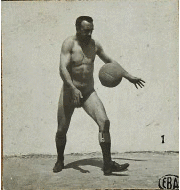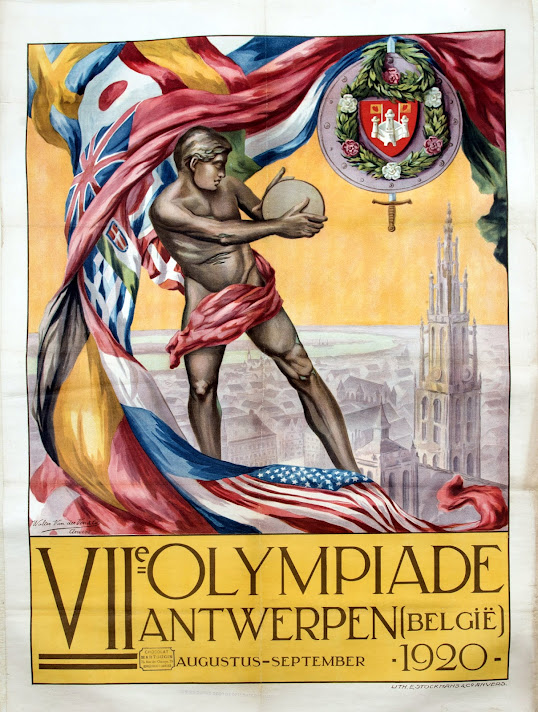Olympics 1896-1920
Today is the start of a series on nudity in Olympic athletes. The modern Olympics started in 1896 in Athens. There was no official poster for the 1896 Olympics. Above is the cover of the 1896 Olympic program. There's no nudity – or is there? To the right of the woman is a small image of a famous sculpture of the naked infant Hercules battling a serpent, which is a story from ancient Greek myth and a reference to the athletes as the modern Hercules.
In the ancient Greek Olympics, the athletes were all male and they competed nude. Unfortunately, this nude tradition was not revived in the modern Olympics, but some Olympic athletes have been photographed nude outside of the games or portrayed nude by artists.
Above, British athlete Launceton Elliot won a gold medal in weightlifting in the 1896 Olympics.
Greek runner Spyros Louis won the marathon in the 1896 Olympics. The 1989 statue above, In Memory of Spyros Louis by Nikolaos Perantinos, honors him in a modern version of an ancient Greek kouros statue.
The 1900 Olympics were held in Paris, along with a World's Fair. Many athletes didn't know whether they were competing in Olympic events or World's Fair events.
French scientist and polar explorer Jean Baptiste Charcot won two silver medals in sailing in the 1900 Olympics. Ten years earlier, he had been photographed nude kicking a football (above) by motion picture pioneer Albert Londe.
The 1904 Olympics were held in St. Louis, also in conjunction with a World's Fair. Again, there was confusion about whether competitions were Olympic events or World's Fair events.
I couldn't find any nude photos of 1904 athletes, but the statue above of Estonian wrestler Georg Lurich by Estonian sculptor Amandus Adamson won an art contest at the World's Fair.
Lurich did not compete in the 1904 Olympics, but here's a photo of him posing as Hercules, c. 1900.
This butt-naked statue of Vulcan was also exhibited at the 1904 World's Fair, above. It's the largest cast-iron statue in the world, and it now resides in Birmingham, Alabama.
Another butt is seen on this Grand Prize certificate for the World's Fair. Olympic gold medals were also awarded.
The 1908 Olympics were held in London, and it was finally just an Olympics, not a World's Fair, so there was no confusion about the competitions and the awards. Above is a gold medal from the 1908 Olympics depicting a naked athlete being crowned with a laurel wreath.
The 1912 Olympics in Stockholm, Sweden, had the first official Olympic poster, above, with an almost-nude figure waving the Swedish flag.
One of the Olympic athletes in 1912 was Swedish runner Ivan Lönnberg. He later became a painter, and this is a self-portrait from 1914.
The 1916 Olympics were cancelled due to World War I.
The 1920 Olympics were held in Antwerp, Belgium. Above, a 1920 Olympic poster.
French weightlifter Ernest Cadine, above, won a gold medal in the 1920 Olympics.
And here's a more revealing photo of Cadine.
Next time: Olympic games 1924 to 1932.


%20by%20Nikolaos%20Perantinos,%201989.jpg)


.jpg)
%20at%20World's%20Fair.jpg)



%20'Self%20Portrait',%201914.jpg)



13 comments:
I have a stamp with the Estonian man, Lurich, on it. But it's not a money shot.
Can't wait to see Part II!
very interesting!
Excellent!
Interesting. Thanks for your research.
Nude Olympics! Great series and looking forward to more installments.
oh Cadine! wonderful, look forward to the next - brilliant idea, thanks
One version of the origin of Ancient Olympic nudity is that when a runner accidently lost his loincloth, it was observed that he ran faster and won. Others then copied his "uniform" in all contests, but only males could be spectators, with death as the punishment for violators. A wrestler's mother got into the stadium by posing as her son's coach, trainer, or manager. After being caught, she pleaded "motherly love" and won respite from the sentence. Afterwards, officials, etc. were also required to be naked at the Games.
Above Cadine on the wall are what appear to be more athletic nudes. Recursion!
Mr. Georg Lurich was thick man
Gold medal!
Always love your Olympic series!
You always have such great selections!
These are wonderful!
Id love to see this.
Post a Comment